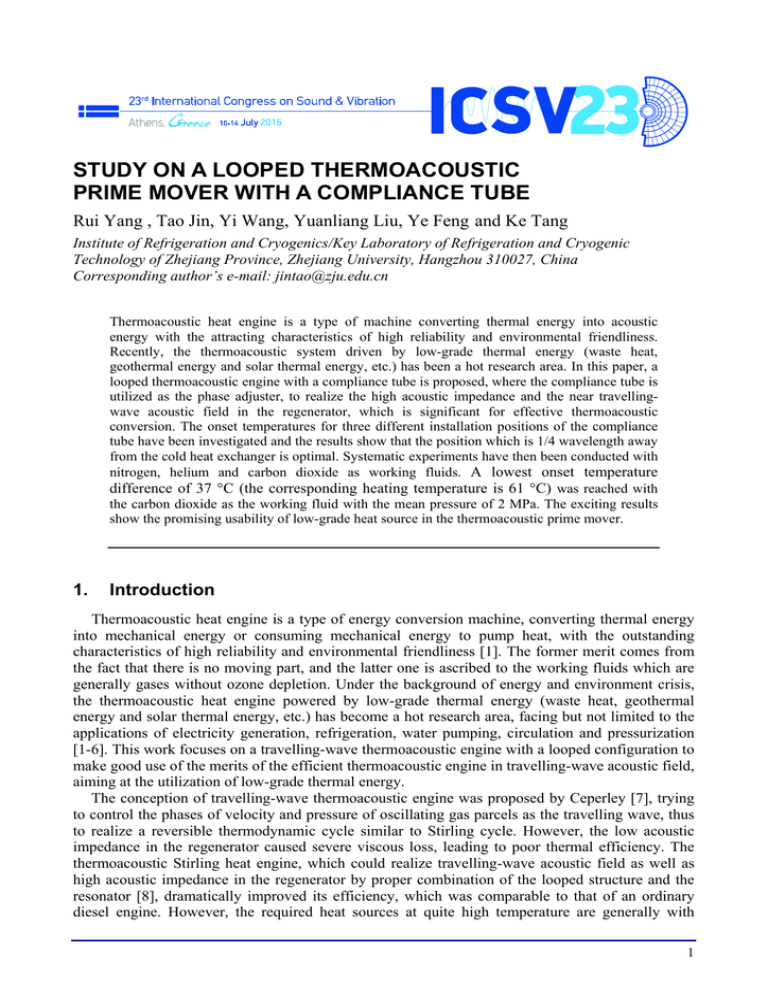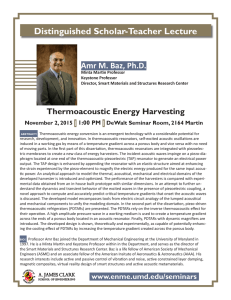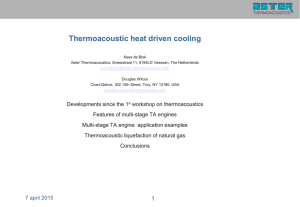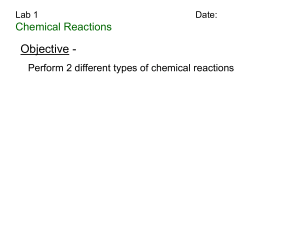study on a looped thermoacoustic prime mover with a
advertisement

STUDY ON A LOOPED THERMOACOUSTIC PRIME MOVER WITH A COMPLIANCE TUBE Rui Yang , Tao Jin, Yi Wang, Yuanliang Liu, Ye Feng and Ke Tang Institute of Refrigeration and Cryogenics/Key Laboratory of Refrigeration and Cryogenic Technology of Zhejiang Province, Zhejiang University, Hangzhou 310027, China Corresponding author’s e-mail: jintao@zju.edu.cn Thermoacoustic heat engine is a type of machine converting thermal energy into acoustic energy with the attracting characteristics of high reliability and environmental friendliness. Recently, the thermoacoustic system driven by low-grade thermal energy (waste heat, geothermal energy and solar thermal energy, etc.) has been a hot research area. In this paper, a looped thermoacoustic engine with a compliance tube is proposed, where the compliance tube is utilized as the phase adjuster, to realize the high acoustic impedance and the near travellingwave acoustic field in the regenerator, which is significant for effective thermoacoustic conversion. The onset temperatures for three different installation positions of the compliance tube have been investigated and the results show that the position which is 1/4 wavelength away from the cold heat exchanger is optimal. Systematic experiments have then been conducted with nitrogen, helium and carbon dioxide as working fluids. A lowest onset temperature difference of 37 °C (the corresponding heating temperature is 61 °C) was reached with the carbon dioxide as the working fluid with the mean pressure of 2 MPa. The exciting results show the promising usability of low-grade heat source in the thermoacoustic prime mover. 1. Introduction Thermoacoustic heat engine is a type of energy conversion machine, converting thermal energy into mechanical energy or consuming mechanical energy to pump heat, with the outstanding characteristics of high reliability and environmental friendliness [1]. The former merit comes from the fact that there is no moving part, and the latter one is ascribed to the working fluids which are generally gases without ozone depletion. Under the background of energy and environment crisis, the thermoacoustic heat engine powered by low-grade thermal energy (waste heat, geothermal energy and solar thermal energy, etc.) has become a hot research area, facing but not limited to the applications of electricity generation, refrigeration, water pumping, circulation and pressurization [1-6]. This work focuses on a travelling-wave thermoacoustic engine with a looped configuration to make good use of the merits of the efficient thermoacoustic engine in travelling-wave acoustic field, aiming at the utilization of low-grade thermal energy. The conception of travelling-wave thermoacoustic engine was proposed by Ceperley [7], trying to control the phases of velocity and pressure of oscillating gas parcels as the travelling wave, thus to realize a reversible thermodynamic cycle similar to Stirling cycle. However, the low acoustic impedance in the regenerator caused severe viscous loss, leading to poor thermal efficiency. The thermoacoustic Stirling heat engine, which could realize travelling-wave acoustic field as well as high acoustic impedance in the regenerator by proper combination of the looped structure and the resonator [8], dramatically improved its efficiency, which was comparable to that of an ordinary diesel engine. However, the required heat sources at quite high temperature are generally with 1 The 23rd International Congress on Sound and Vibration relatively high quality [8], which severely limits its practical application scope. In 2010, de Blok modified the looped travelling-wave thermoacoustic engine by inserting multiple thermoacoustic cores in the loop, and the exciting results showed that the required temperature of heat source was significantly reduced. The multi-stage travelling-wave thermoacoustic engine was expected to realize a relative Carnot efficiency of 40% when driven by the heat sources below 200 °C [3, 4]. The present work proposed a looped thermoacoustic engine with a compliance tube, which is utilized as the phase adjuster, in order to realize the high acoustic impedance and the near travelling-wave acoustic field in the regenerator. To find the optimal location for the compliance tube, the onset temperatures of three different installation positions have been investigated. Detailed investigation has then been carried out when the compliance tube is installed in the optimal position. The prime mover has also been modelled to evaluate the efficiency. 2. Qualitative analysis of the regenerator based on a simplified model and the conception of compliance tube For a travelling-wave thermoacoustic prime mover, the regenerator is the place where the thermoacoustic conversion occurs. Hence, it is significant to conduct a qualitative analysis on the performance of thermoacoustic conversion in the regenerator. According to the thermoacoustic theory [9], the variation in the acoustic power through an element channel with the length of dx in one dimensional case can be depicted as r dE 2 1 1 = − ν |U 1 |2 − |p1 |2 + Re [ gp 1U 1 ] , dx 2 2 rκ 2 (1) where E2 is the acoustic power, rν is the resistance caused by viscosity, rκ is the effective resistance of thermal relaxation. U1 and p1 are the amplitudes of volumetric velocity and pressure, respectively. g is a sort of complex gain or attenuation coefficient for the volumetric velocity. Re represents the real part of a complex number. The tilde denotes complex conjugation. As for Eq. (1), the first and second terms on the right side are the acoustic power dissipations caused by fluid viscosity and thermal relaxation, respectively. The third term represents the acoustic power gain or attenuation. Generally, rν, rκ and g are functions of the geometry and dimensions of the channel, and g is even related to the temperature gradient along the channel [9]. For an ideal regenerator with perfect thermal contact between the working fluid and the solid channel boundary, as well as zero void volume, rκ is infinite, and g can be simplified into [9] g= 1 dTm , Tm dx (2) where Tm is the mean temperature. Consequently, Eq. (1) can be simplified into r dE2 1 dTm = − ν |U 1 |2 + | p1 ||U 1 | cosϕ , dx 2 2Tm dx (3) where φ is the phase difference between p1 and U1. In addition, the expressions of rν and U1 are [9] rν = ωρ m Im[ − f ν ] A |1 − f ν |2 , U1 = v1 A , (4) (5) where ω, ρm, v1 and A are the angular frequency, the mean density, the velocity amplitude, and the channel cross-sectional area, respectively. fν is the spatially averaged viscous function [9]. Combining Eqs. (3), (4) and (5), by eliminating rν and U1, yields 2 ICSV23, Athens (Greece), 10-14 July 2016 The 23rd International Congress on Sound and Vibration dE2 1 dTm ωρ A Im[ − f ν ] =− m | v1 |2 + | p1 ||U1 | cosϕ . 2 dx 2 |1 − f ν | 2Tm dx (6) The first term on the right side in Eq. (6) indicates that decreasing the velocity amplitude |v1|, instead of the volumetric velocity amplitude |U1|, is the essential approach to reducing the viscous dissipation. According to the second term on the right side in Eq. (6), for a given mean temperature and temperature gradient, the higher values of |p1|, |U1| and cosϕ are all expected to enlarge the acoustic power generation for the engine’s regenerator. Especially, it is most beneficial to thermoacoustic conversion when φ is 0. Consequently, we could conclude that, as for the design of a travelling-wave thermoacoustic engine, the following two points can be suggested for the regenerator: 1) high normalized acoustic impedance, i.e., Zn>>1 (Zn=|p1/v1|/ρmc, where c is the sound speed), implying a relatively high pressure amplitude |p1| and a relatively low velocity amplitude |v1|. 2) phase difference φ close to zero, leading to cosϕ approaching to 1. To achieve near travelling-wave acoustic field in the regenerator, the compliance tube with larger diameter than the adjacent tubes is proposed. In the simplified model, the compliance tube can be modelled as a compliance. If the viscous and thermal attenuation is neglected, when sound wave travels through the compliance tube, p1 remains unchanged while ΔU1 can be depicted as [9] ΔU1 = −iωCp1 (7) where C is the compliance. As a result, the variation in the phase of volumetric velocity amplitude ph(U1) is accelerated, and the acoustic field in the regenerator can be adjusted. From Eq. (7), we can see that the change of U1 depends on not only the configuration of the compliance tube, but also p1, indicating the position to install the compliance tube plays an important role. 3. Experimental apparatus Based on the two key points of an efficient regenerator and the conception of the compliance tube mentioned in Section 2, we proposed a looped thermoacoustic engine as shown in Fig. 1, consisting of a thermoacoustic core (a heater, a regenerator and a cold heat exchanger) and a compliance tube, which are connected by resonators to form a loop. Dimensions of the main parts are listed in Table 1. The cross-sectional area of the thermoacoustic core is locally enlarged, in order to reduce the velocity amplitude |v1| for decreasing viscous dissipation inside the regenerator, while keeping a sufficient |U1| which is beneficial to the acoustic power gain, according to Eq. (6).The compliance tube, with the length equal to that of the thermoacoustic core and the diameter 2.77 times that of the resonator, acts as a phase adjuster. Six pressure sensors are installed along the loop. We tried different positions to install the compliance tube, as shown in Fig. 1. 4. Results and discussions Figure 2 shows the onset temperature difference in the system when the compliance tube is installed in position 1, position 3 and is not installed. It can be seen that the onset temperature differences can be reduced greatly by installing the compliance tube in both positions 1 and 3. However, in position 3, the system oscillates in a very unstable state, which is similar with the compressor surge. More specifically, the intensity of the oscillation varies dramatically with the period of about 5 s. This is because the inappropriate acoustic filed triggers the double-threshold phenomenon [10], i.e., there are two separated regimes of the exponential growth of acoustic oscillations. After the first threshold, the heating temperature rises steadily until reaching the critical value of the second threshold. The oscillation abruptly becomes much more intense, and the convective heat transfer between the gas and the wall of the heater is enhanced. However, the ICSV23, Athens (Greece), 10-14 July 2016 3 Onset temperature difference (°C) The 23rd International Congress on Sound and Vibration 500 400 Position 1 Position 3 Without compliance tube 300 200 Gas: CO2 100 0 0.0 0.5 1.0 1.5 2.0 Mean pressure (MPa) 2.5 Figure 1: Schematic of the looped travelling-wave Figure 2: Onset temperatures when the compliance thermoacoustic prime mover. tube is installed in position1, 3 and is not installed. Table 1: Dimensions of the main parts of looped thermoacoustic prime mover. Items Length (mm) Diameter (mm) Heater 30 99 Regenerator Cold heat exchanger 30 30 99 99 Resonator Compliance tube 90 8160 72 26 heating power cannot sustain the required heating temperature, so the heating temperature will drop below the critical value of the second threshold, and the oscillation becomes weaker again. The standing-wave ratio of this case is above 5, which reflects that the acoustic filed contains much standing-wave components, and is not well adjusted. Additionally, the oscillation fails to occur when the compliance tube is installed in position 2, even at the highest heating temperature of 600 °C. There are two possible reasons may account for the phenomenon. Firstly, the phase difference φ can be changed but in the deteriorated direction by the compliance tube in position 2. According to Eq. (6), if φ is close to 90°, the acoustic wave cannot be amplified. Secondly, the compliance tube, which may help to form a boundary similar with the soft boundary, will lead to the compliance and the regenerator near the peak of U1, and then to severe viscous loss according to Eq. (3). Both of the two explanations are merely conjectures and further research efforts are required to provide a more definitive answer. In our experiments, only when the compliance tube is installed in position 1, the system could start to oscillate at low heating temperature and in a stable state. The detailed study has also been carried out when the compliance tube is in position 1. Figure 3 presents the onset temperature difference of the prime mover with different mean pressures when He, CO2 and N2 are adopted as working fluids, respectively. As we can see, the system could start to oscillate with relatively low temperature differences, indicating the potential to use low-grade thermal energy. A lowest onset temperature difference of 37 °C (the corresponding heating temperature is 61 °C) was achieved with CO2 of 2 MPa as the working fluid. Figures 4 to 6 show the stable operating status under different heating powers when the filling pressure is 2 MPa. From Fig. 4, we can see that the temperature difference along the regenerator rises steadily with the increased heating power, and the temperature difference are below 250 °C, which can be provided by many low-grade heat sources. We can see from Fig. 5 that the frequency for the case of He is the highest, then is N2, and finally is CO2. The frequency can be determined by the ratio of sound speed over wavelength. As the heating temperature rises with the elevating heating power, the sound speed of the gas near the heater is generally increased. However, the temperature in the loop far away from the heater stays almost unchanged, leading to an unremarkable rise in the spatial average sound speed of the system. Since the wavelength depends on the loop length, the frequency rises but unremarkably. Figure 6 presents the relation of pressure 4 ICSV23, Athens (Greece), 10-14 July 2016 300 250 He CO2 200 N2 150 100 50 Temperature difference (°C) Onset temperature difference (°C) The 23rd International Congress on Sound and Vibration 250 200 He CO2 N2 150 100 0.5 1.0 1.5 2.0 Mean pressure (MPa) 2.5 1.25 120 1.20 90 60 Pressure ratio 150 He CO2 N2 30 1.15 He CO2 N2 1.10 1.05 0 0.0 0.2 0.4 0.6 0.8 1.0 1.2 1.4 Heating power (kW) 1.00 0.0 0.2 0.4 0.6 0.8 1.0 1.2 1.4 1.6 Heating power (kW) Figure 5: Frequency vs. heating power. Figure 6: Pressure ratio vs. heating power. 300 Acoustic power amplification in regenerator 250 200 Efficiency 0.25 0.20 150 100 Gas: He 0.15 Efficiency Acoustic power amplification (W) Frequency (Hz) 50 0.0 0.2 0.4 0.6 0.8 1.0 1.2 1.4 Heating power (kW) Figure 3: Onset temperature difference for different gas. Figure 4: Temperature difference vs. heating power. 0 0.0 50 0 0.10 0.2 0.4 0.6 0.8 1.0 1.2 1.4 1.6 Heating power (kW) Figure 7: The calculated acoustic power amplification in regenerator and the efficiency. ratio (defined as the ratio of pressure amplitude over mean pressure) versus heating power, showing the intensity of pressure oscillation. Generally, a higher pressure ratio is expected to drive the load, such as a linear alternator or a refrigerator. A highest pressure ratio of 1.20 was achieved when CO2 was adopted as working fluid, with a corresponding temperature difference of 224 °C. To evaluate the acoustic power amplification in the regenerator, the system is modelled by DeltaEC [11], where the mean pressure and heating/cooling temperatures are the measured values from the experiments. The calculated |p1| has been compared with the measured results from six pressure sensors installed along the loop, and the deviation is within 30%. Figure 7 shows that the calculated acoustic power amplification in the regenerator and the efficiency (defined as the ratio of ICSV23, Athens (Greece), 10-14 July 2016 5 The 23rd International Congress on Sound and Vibration the calculated acoustic power amplification over the corresponding measured heating power) both rise with the elevating heating power. The efficiency ranges from 0.11 to 0.18, and the relative Carnot efficiency ranges from 0.37 to 0.43. 5. Conclusion In summary, this paper presents a looped travelling-wave thermoacoustic prime mover, where a compliance tube has been adopted to adjust the acoustic field. In order to find the best place to install the compliance tube, 3 different positions has been tested. The experimental results show that by inserting a compliance tube locating about 1/4 wavelength away from the cold heat exchanger, the onset temperature difference can be dramatically decreased and the system can oscillate under a stable state. The detailed investigation of the system with the appropriately located compliance tube indicates the promising potential to use low grade heat to drive the prime mover. ACKNOWLE DGEMENT This work is financially supported by the National Natural Science Foundation of China (Grant No. 51276154, No. 51576170) and the University Doctoral Subject Special Foundation of China (Grant No. 20120101110148). REFERENCES 1 Jin, T., Huang, J., Feng, Y., Yang, R., Tang, K. and Radebaugh, R. Thermoacoustic Prime Movers and Refrigerators: Thermally Powered Engines without Moving Components, Energy, 93 (1), 828-853, (2015). 2 Yu, Z., Jaworski, A. J. and Backhaus, S. Travelling-wave Thermoacoustic Electricity Generator Using an Ultra-Compliant Alternator for Utilization of Low-Grade Thermal Energy, Applied Energy, 99, 135145, (2012). 3 de Blok, K. Novel 4-stage Travelling Wave Thermoacoustic Power Generator, Proceedings of ASME 2010 3rd Joint US-European Fluids Engineering Summer Meeting collocated with 8th International Conference on Nanochannels, Microchannels, and Minichannels, Montreal, Canada, 2-4 August, (2010). 4 de Blok, K. and Systemen, A. T. Multi-stage Travelling Wave Thermoacoustics in Practice, Proceedings of 19th International Congress on Sound and Vibration, Vilnius, Lithuania, 8-12 July, (2012). 5 Hasegawa, S., Yamaguchi, T. and Oshinoya, Y. A Thermoacoustic Refrigerator Driven by a Low Temperature-differential, High-efficiency Multistage Thermoacoustic Engine, Applied Thermal Engineering, 58 (1), 394-399, (2013). 6 Jin, T., Chen, G. B. and Shen, Y. A Thermoacoustically Driven Pulse Tube Refrigerator Capable of Working below 120 K, Cryogenics, 41 (8): 595-601, (2001). 7 Ceperley, P. H. A Pistonless Stirling Engine—the Traveling Wave Heat Engine, The Journal of the Acoustical Society of America, 66 (5), 1508-1513, (1979). 8 Backhaus, S. and Swift, G.W. A Thermoacoustic Stirling Heat Engine, Nature, 399(6734), 335-338, (1999). 9 Swift, G. W. Thermoacoustics: a Unifying Perspective for Some Engines and Refrigerators, 5th Ed., AIP Press, New York, (2002). 10 Penelet, G., Gaviot, E., Gusev, V., Lotton, P. and Bruneau, M. Experimental Investigation of Transient Nonlinear Phenomena in an Annular Thermoacoustic Prime-mover: Observation of a Double-threshold Effect, Cryogenics, 42 (9), 527-532, (2002). 11 Ward, B., Clark, J. and Swift, G.W. Design environment for low-amplitude thermoacoustic energy conversion, DeltaEC Version 6.2 users guide. [Online.] available: http://www.lanl.gov/thermoacoustics. 6 ICSV23, Athens (Greece), 10-14 July 2016






